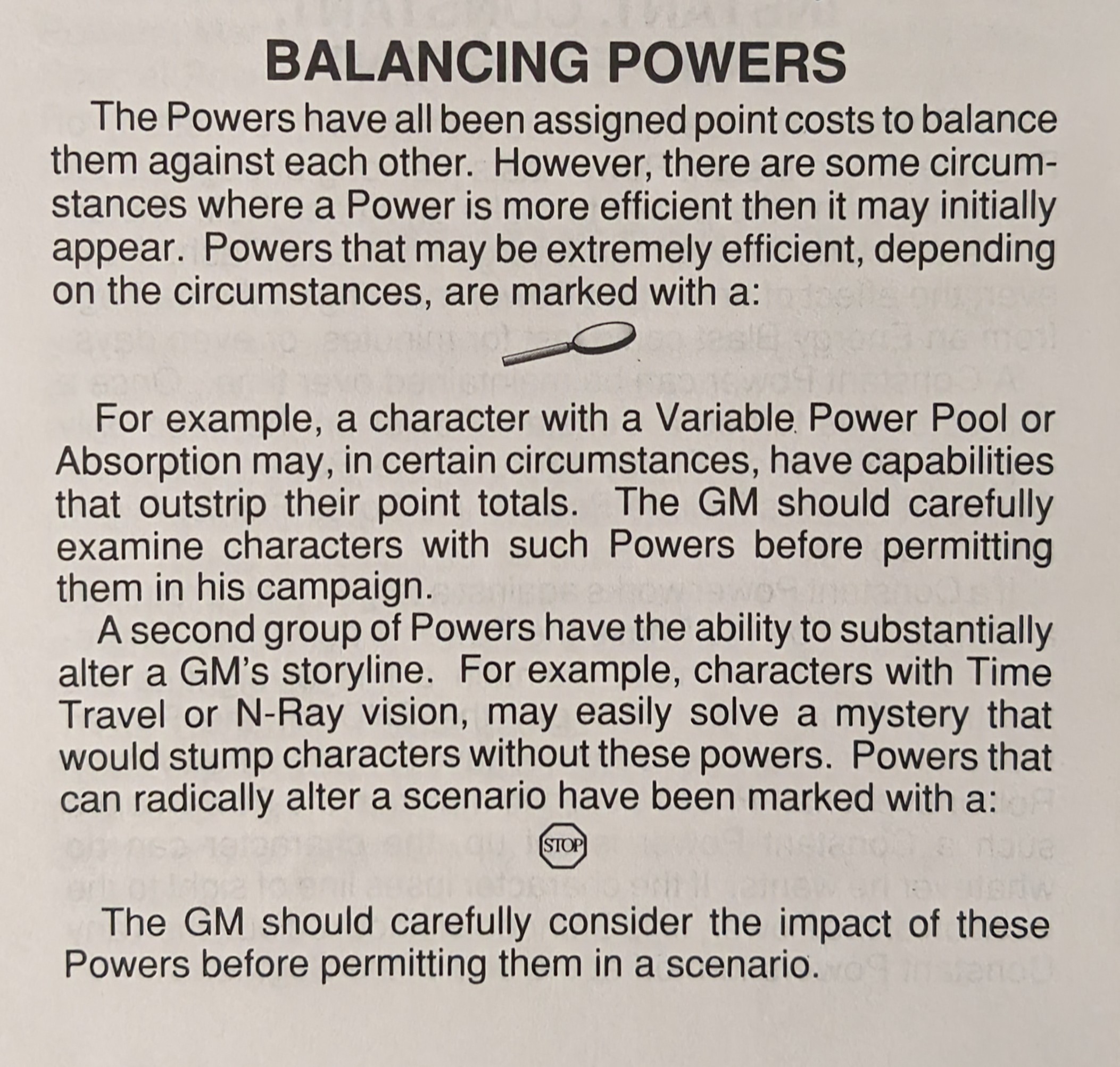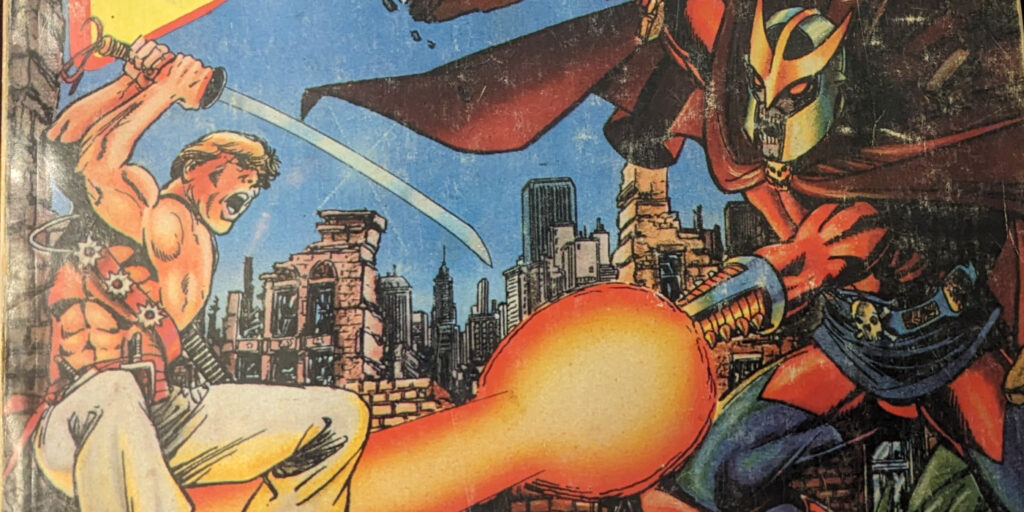Last week, I wrote about the 80’s Marvel RPG Marvel Super Heroes and how it approaches statting out a superhero. Today, we continue our survey of superheroic roleplaying games with 1989’s Champions 4th edition!

Champions operates on a the points-based HERO system, which gave me intense flashbacks to my short time as a GURPS player in high school. The book I have is the 4th edition, an attempt to streamline and standardize the shared rules of other HERO system games, like the pulp-inspired Justice, Inc. and the sci-fi Star Hero. Champions’ strategy for making superheroes work is to separate out “heroic” vs “superheroic” campaigns. In a heroic campaign, such as secret agents or high fantasy adventurers, characters generally rely on their Skills, Perks, and Talents, with some Powers thrown in for the occasional weird spell or preternatural ability. In addition to their Skills, Perks, and Talents, heroic characters also buy a suite of equipment their Money.
Superheroic campaigns, on the other hand, exclusively use points. They are actually prohibited from buying gear with money, both as a balance strategy and to stay in line with genre conventions. This divide between heroic and superheroic campaigns indicates that the designers behind Champions recognized that something would feel off about superheroes being represented mechanically in the same way as characters in other genres. The book offers a lengthy explanation for this system, included below:
“Characters in a superheroic campaign must pay Character Points for everything. This includes Skills, Talents, Powers, and equipment. This does not mean that a character can’t grab a supervillain’s blaster in combat and fire it – there is no mystical force preventing him from acquiring equipment. But if the character wants to continue using the equipment, then he will have to pay points for it.
Why is this? Why can’t a superhero go to a store and buy a transistor radio or a gun? The reasons are twofold. The first involves fairness to all characters. A character who can naturally hear radio will have to spend his precious Character Points for the ability. It is unfair to this character for other characters to be able to simply go out and buy a transistor radio with money, and thereby acquire the same ability. The same holds true for guns, body armor, and life support devices. By forcing characters to pay Character Points for all equipment and abilities, game balance is enforced.
Second, making characters pay Character Points helps GMs enforce the superheroic genre. In comic books, heroes and villains don’t usually go out and buy transistor radios, even when doing so might make sense. Similarly, many a superhero would be better off if he had a gun – even if he never used it on a living opponent. So why doesn’t he? Because he’s a superhero. Similarly, superheroes in superheroic campaigns won’t simply go out and stock up on merchandise – they’ll have to pay points first.”
Champions The Super Role-Playing Game 4th edition pg. 9
These paragraphs are fascinating to me, and not just for the supposition that every superhero would be better off packing heat. I think the problem the designers have identified is genuine: superheroes don’t operate by the same rules as fantasy heroes or secret agents. And the solution is pretty elegant: Make every character use points. One character might spend points on super strength, another on gadgets. Every kind of hero is expressed with the same mechanical vocabulary, which allows you to include metahumans, mutants, weird science, and super sorcery and keep them all “balanced.”
But do these stated reasons make any sense?
In the first example, I think it’s pretty obvious that having an innate, natural ability to hear radio waves is far superior to having a transistor radio in your back pocket. If I paid for Radio Hearing, which costs a measly 3 points (Superheroes start with 100 points, with the option to take a further 150 via Disadvantages), I don’t think I’d begrudge someone else for buying a similar item that could easily be lost, broken, or hacked. Heck, for just 2 more points I can upgrade to Radio Listen and Transmit so I can transmit on AM, FM, and Police bands as well as monitor them. For 10 points, I can get High Range Radio Hearing and transmit “up and down the radio and television communication bands,” plus sense radar emissions and “search for a specific frequency” with a successful roll. What about armor and guns? For just 12 points, I can have the Armor Power at a level slightly better than Heavy Kevlar. It’s invisible, it’s always active, it weighs nothing. If my partner wants to go into battle with Heavy Kevlar they stole from a fallen soldier, I don’t know that I really would feel outdone.
So how about that second point? That it helps the GM “enforce the superheroic genre.” What I think we’re seeing here is a game that knows the tone it wants to achieve but that doesn’t really have a way to articulate that outside of “It’s the GM’s job to keep the players in check.” This paragraph is making an accurate observation that it really wouldn’t feel right for Batman to loot the corpses of his enemies and go into battle against the Joker kitted out in a flak jacket and waving an uzi. But rather than assuming the players will share this belief and roleplay accordingly, it feels like Champions is actively afraid that players will do superheroes wrong and try to go against the genre in their pursuit of an optimal build. I think we’re probably seeing the shadow of the D&D tournament and the “adversarial DM” dynamic. In some ways, Champions sets up this assumption itself. The very first paragraph of this book contains the following:
“With these rules and your pencils, paper, and imagination, you can recreate the fanciful world of the comic books and adventure novels. But beware! Champions is not a game for the weak at heart. It takes guts, intelligence, and imagination to succeed. Can you meet the challenge?”
Champions The Super Role-Playing Game 4th edition pg. V
Right away, this book is telling you that you have to be cunning and inventive to succeed. But, like, make sure you’re also keeping in line with the genre. We see another example of this tension cropping up in the Powers section. The book assures us that the powers have been balanced with their point costs, but acknowledges that certain powers may be “more efficient then [sic] it may initially appear.” These powers are marked with a very large magnifying glass, encouraging the GM to monitor them closely and decide if/how to allow their use. A further set of powers is marked with a stop sign, indicating Powers that “Have the ability to substantially alter a GM’s storyline.” Powers in the first group include Absorption (which can use absorbed damage to enhance other Powers) and Characteristics, which can be used to just dump points into a character’s core attributes like Strength and Dexterity. The “stop” Powers are things like Clairsentience, the ability to see far off locations or even into the future, or Extra-Dimensional Movement.
Again, it’s perfectly reasonable to identify that the presence of these powers, which crop up in comics all the time, can be difficult to play around. But like with the gear conversation, the game doesn’t really seem to know any way to convey this concern other than “it’s the GM’s job to keep these things in line!”

Stop! A super power!
So what does that leave us with? Champions seems somewhat similar to Marvel Super Heroes on the outside – characters are a collection of statistics and assets detailing exactly what they can do and to what extent. In Marvel Super Heroes, Captain America can lift 2000 lbs. thanks to his Strength. The Cap analog in Champions, Crusader, has a Strength of 20, which translates to a Lift of 400kg. There’s a lot more flexibility in Champions thanks to the Power modifiers. Powers can be made situational, expanded in their use, and pretty thoroughly customized with both improvements and detriments. Rather than a series of powers used to define existing characters, this is a highly flexible toolbox you can use to make any character you want.

But with that enhanced customization comes an almost paranoid attempt to hold onto “balance.” Marvel Super Heroes had very little interest in balance, really. Characters were either pre-made, randomly rolled, or vaguely modeled through collaboration between player and GM. I honestly think the writers and designers didn’t want to even entertain the idea that anyone would do something “wrong” when playing as Spider-Man. He’s Spider-Man after all, of course he’s not going to go buy a gun. But Champions is very concerned not only with making sure all the players are on a relatively even playing field, but also that nothing the players do messes with the GM’s storyline or subverts their ability to “enforce the genre.” I don’t really say any of this to put Champions down. I actually really like building characters in systems like this, even if I don’t think I’d always like playing them. Rather, I think this is evidence of a friction, even in this revised version of the game, between the conventions of the genre and the capabilities of the system as written.
At the end of the day, Champions stands out as a great example of the fact that superheroes don’t play well with the mechanical structure of other early RPGs, like D&D or Traveller. The HERO system has some rules for bridging that gap, but it does so while still carrying a lot of the baggage of what came before. I know Champions has had a steady series of updates and new editions over the years, but I don’t have any of those in my collection and I’m keeping this survey to books I’ve picked up in person.
Next time, we’ll be leaping forward to the far-flung future of 2006 with the Mutants & Masterminds Pocket Player’s Guide.